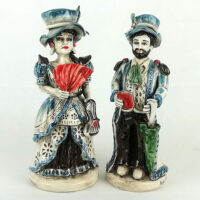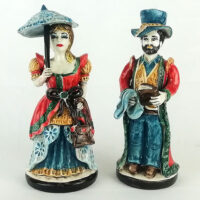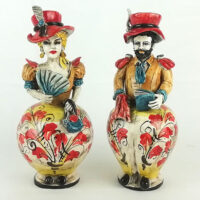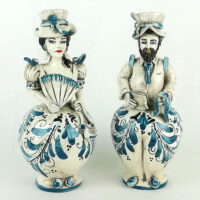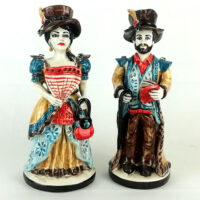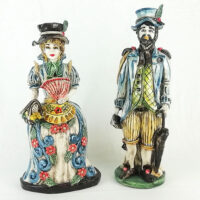Ceramic Lights from Caltagirone
Ceramic Lights or Oil Lamps from Caltagirone.
The ceramic lights or oil lamps, once prevalent in every home, were closely related to the function of lamps. The production of ceramic lights ceased with the appearance of oil lamps and ended completely with the advent of electric light.
In noble courts, the lights were made of bronze or copper, while in common houses, they were made of terracotta. The most common shape of terracotta lights was that of a small circular bowl with a handle and a spout at the rim.
A different form was taken by the majolica lights of the 16th century in eastern Sicily, particularly those from Caltagirone.
The Lights of Caltagirone

In Caltagirone, the plastic processing of ceramics, inspired by Sicilian Baroque tradition, was added to turning, integrating and enriching it. This led to the creation of anthropomorphic lamps.
The idea of figurine-lamps arose from the evolution of ceramists on how to embellish and introduce ceramics into noble environments, considering it a poor material.
Plastic decoration through elegant figurines was a valid means to transition ceramic lights from the lower classes to the noble ones.
The 16th-century majolica lights, representing exclusively noblewomen in matronly poses, with one arm by their side and the other at their waist, richly adorned with necklaces and diadems, were essentially elegant oil containers, capable of fully and more autonomously replacing metallic lights. In fact, in their bottle-shaped body, originally obtained from the lathe and then, subsequently, from frontal modeling, by casting but always internally empty, a long wick was immersed that externally emerged behind the frontal diadem.
Due to their capacity, ceramic lights could provide light for a long time, but due to their weight, they were cumbersome to move, and they were difficult to fill, as the oil was poured through the same (quite narrow) hole through which the wick passed.
This type of molded ceramic lights continued throughout the 17th century and had to coexist in salons with majolica candelabras.
The 18th Century Lights
In the 18th century, ceramic lights underwent a significant change; the form was returned to turning and direct modeling, without the use of molds. The heavy and capacious tank disappeared, and only a small basin, obtained in the head of the lamp, was used to contain the oil.
The empty and bottomless light has a raised edge at the base for the eventual collection of oil poured from above.
In the 18th century, thanks to the work of ceramists from Caltagirone, ceramic lights assumed new forms.
Thus, there were richly dressed ladies, gentlemen, monks, priests, brigands, historical figures, and other characters drawn from everyday life.
The rich decoration of Caltagirone ceramics allowed these subjects to enter noble homes and salons, fully replacing metallic lights that, compared to them, even though more expensive, were chromatically monotonous and poorly decorated.
The most sought-after anthropomorphic light was and is the lady with a fan
 and bell-shaped dress, all lace, which in the 18th and 19th centuries replaced the austere matron of the 16th and 17th centuries.
and bell-shaped dress, all lace, which in the 18th and 19th centuries replaced the austere matron of the 16th and 17th centuries.
Unlike this, decorated in blue with some touches of yellow, the 18th-century one stands out for its lively polychromy, constituting one of the most characteristic works to come out of the hands of Caltagirone ceramists.
Perhaps for this reason, today, despite having lost its practical function, it is in great demand, and Caltagirone master ceramists include it among the main objects of their production repertoire.

 Italiano
Italiano

